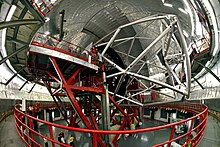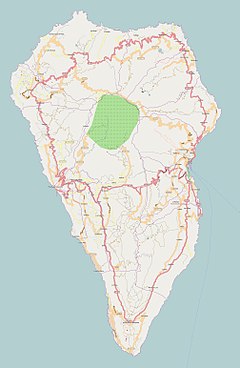astro.wikisort.org - Institution
The Gran Telescopio Canarias (GranTeCan or GTC) is a 10.4 m (410 in) reflecting telescope located at the Roque de los Muchachos Observatory on the island of La Palma, in the Canaries, Spain. It is the world's largest single-aperture optical telescope.[1]
 Gran Telescopio Canarias, 2008 | |
| Alternative names | GranTeCan |
|---|---|
| Part of | Unique Scientific and Technical Infrastructures Roque de los Muchachos Observatory |
| Location(s) | La Palma, Garafía, La Palma, Spain |
| Coordinates | 28°45′24″N 17°53′31″W |
| Organization | Instituto de Astrofísica de Canarias National Autonomous University of Mexico University of Florida |
| Observatory code | Z18 |
| Altitude | 2,267 m (7,438 ft) |
| Built | 2002–2008 |
| First light | 13 July 2007 |
| Telescope style | optical telescope Ritchey–Chrétien telescope segmented mirror telescope |
| Diameter | 10.4 m (34 ft 1 in) |
| Collecting area | 78.54 m2 (845.4 sq ft) |
| Focal length | 169.9 m (557 ft 5 in) |
| Website | www |
| | |
Construction of the telescope took seven years and cost €130 million.[2][3] Its installation was hampered by weather conditions and the logistical difficulties of transporting equipment to such a remote location.[4] First light was achieved in 2007 and scientific observations began in 2009.[citation needed]
The GTC Project is a partnership formed by several institutions from Spain and Mexico, the University of Florida, the National Autonomous University of Mexico,[5][better source needed] and the Instituto de Astrofísica de Canarias (IAC). Planning for the construction of the telescope, which started in 1987, involved more than 1,000 people from 100 companies.[3] The division of telescope time reflects the structure of its financing: 90% Spain, 5% Mexico and 5% the University of Florida.
History

First light
The GTC began its preliminary observations on 13 July 2007, using 12 segments of its primary mirror, made of Zerodur glass-ceramic by the German company Schott AG. Later, the number of segments was increased to a total of 36 hexagonal segments fully controlled by an active optics control system, working together as a reflective unit.[4][6] Its first instrument was the Optical System for Imaging and low Resolution Integrated Spectroscopy (OSIRIS). Scientific observations began in May 2009.[7]
Inauguration ceremony
The Gran Telescopio Canarias formally opened its shutters on July 24, 2009, inaugurated by King Juan Carlos I of Spain.[8] More than 500 astronomers, government officials and journalists from Europe and the Americas attended the ceremony.
MEGARA

MEGARA (Multi-Espectrografo en GTC de Alta Resolucion para Astronomia) is an optical integral-field and multi-object spectrograph covering the visible light and near infrared wavelength range between 0.365 and 1 µm with a spectral resolution in the range R=6000-20000. The MEGARA IFU (also called the Large Compact Bundle, or LCB) offers a contiguous field of view of 12.5 arcsec x 11.3 arcsec, while the multiobject spectroscopy mode allows 92 objects to be observed simultaneously in a field of view of 3.5 arcmin x 3.5 arcmin by means of an equal number of robotic positioners. Both the LCB and MOS modes make use of 100 µm-core optical fibers (1267 in total) that are attached to a set of microlens arrays (with 623 spaxels in the case of the LCB and 92x7 in the case of the MOS) with each microlens covering an hexagonal region of 0.62 arcsec in diameter.[9]
CanariCam
The University of Florida's CanariCam is a mid-infrared imager with spectroscopic, coronagraphic, and polarimetric capabilities. Since 2012, it had been operating in queue mode at one of the Nasmyth focus stations, until it was temporarily decommissioned in April 2016. Following an upgrade project, started in mid-2018, it has been installed and recommissioned (December 2019) on a different folded-Cassegrain focus providing superior performance with the instrument.[10]
CanariCam is designed as a diffraction-limited imager. It is optimized as an imager, and although it will offer a range of other observing modes, these will not compromise the imaging capability. CanariCam works in the thermal infrared between approximately 7.5 and 25 μm. At the short-wavelength end, the cut-off is determined by the atmosphere—specifically atmospheric seeing. At the long wavelength end, the cut-off is determined by the detector; this loses sensitivity beyond around 24 μm, although the cut-off for individual detectors varies significantly. CanariCam is a very compact design. It is expected that the total weight of the cryostat and its on-telescope electronics will be under 400 kg.[citation needed] Most previous mid-infrared instruments have used liquid helium as a cryogen; one of the requirements of CanariCam was that it should require no expensive and difficult to handle cryogens.[citation needed]
CanariCam uses a two-stage closed cycle cryocooler system to cool the cold optics and cryostat interior down to approximately 28 K (−245 °C; −409 °F), and the detector itself to around 8 K (−265 °C; −445 °F), the temperature at which the detector works most efficiently. CanariCam is operational as of 2021[update].[11]
OSIRIS
The IAC's OSIRIS (Optical System for Imaging and low Resolution Integrated Spectroscopy), is an imager and spectrograph covering wavelengths from 0.365 to 1.05 µm. It has a field of view (FOV) of 7 × 7 arcmin for direct imaging, and 8 arcmin × 5.2 arcmin for low resolution spectroscopy. For spectroscopy, it offers tunable filters.[12]
See also
- Other observatory sites
- Lists and comparisons
- Extremely large telescope
- List of largest optical reflecting telescopes
- List of largest optical telescopes historically
References
- Klotz, Irene (2009-07-24). "New telescope is world's largest ... for now".
- Alvarez, P. "The GTC Project. Present and Future" (PDF). pp. 1–8. Archived from the original (PDF) on 2009-08-16. Retrieved 2009-07-24.
- Moreno, Carlos (2009-07-25). "Huge telescope opens in Spain's Canary Islands".[dead link]
- "Tests begin on Canaries telescope". BBC. 14 July 2007.
- GTC faq GTC digital 8 January 2009
- Giant telescope begins scouring space July 14, 2007 Archived May 11, 2020, at the Wayback Machine
- El Gran Telescopio CANARIAS comienza a producir sus primeros datos científicos IAC Press release June 16, 2009 (Spanish)
- Heckle, Harold (July 24, 2009). "Huge Telescope Opens in Spain's Canary Islands". New York Times.[dead link]
- "MEGARA instrument". guaix.fis.ucm.es. Universidad Complutense de Madrid.
- European Organization For Nuclear Research. "CanariCam@GTC Recommisioning & Lessons Learned". Zendo. CERN. Retrieved 4 July 2022.
- "Observed for the first time a jet of gas as it emerges from the central star of a planetary nebula | Instituto de Astrofísica de Andalucía - CSIC".
- "Instruments Osiris". Gtc.iac.es. Gran Telescopio Canarias.
External links
- Gran Telescopio Canarias
- GTC News
- Instituto de Astrofísica de Canarias (IAC)
- University of Florida CanariCam
- (in Spanish) Consejo Nacional de Ciencia y Tecnología de México
- (in Spanish) Instituto de Astronomía de la Universidad Nacional Autónoma de México
- CBC article—Giant Canary Islands telescope captures first light
- Images
- Gran Telescopo Canarias inauguration press dossier (in English)
- Merrifield, Michael. "Gran Telescopio Canarias". Deep Sky Videos. Brady Haran.
На других языках
[de] Gran Telescopio Canarias
Das Gran Telescopio Canarias (GTC) ist ein astronomisches Großteleskop mit 10,4 m Spiegeldurchmesser auf dem Roque de los Muchachos auf der Kanareninsel La Palma. Gebräuchlich ist auch die Bezeichnung GRANTECAN.- [en] Gran Telescopio Canarias
[es] Gran Telescopio Canarias
El Gran Telescopio Canarias (conocido también como GTC o GRANTECAN) es un proyecto español, que culminó con la construcción del mayor telescopio óptico del mundo.[3] Liderado por el Instituto de Astrofísica de Canarias,[4] el telescopio realizó la primera luz oficial en la madrugada del 13 al 14 de julio de 2007 y comenzó su producción científica a principios del 2009. El 24 de julio de 2009 fue inaugurado oficialmente por los Reyes de España. Las obras comenzaron en el año 2000 en el Observatorio del Roque de Los Muchachos, La Palma, Islas Canarias, España. Sus instalaciones, que se encuentran a 2396 msnm de altitud, junto con el Observatorio del Teide, constituyen el Observatorio Norte Europeo (O.N.E.). En este lugar se reúnen condiciones óptimas para la observación, debido a la calidad del cielo, protegida por una ley ad hoc.[ru] Большой Канарский телескоп
Большой Канарский телескоп (англ. The Gran Telescopio CANARIAS (GTC)) — оптический телескоп-рефлектор с самым крупным зеркалом в мире. Построен в 2007 году. Его первичное шестиугольное зеркало, с эквивалентным диаметром 10,4 метра, составлено из 36 шестиугольных сегментов, изготовленных из ситаллов Zerodur, производства компании Schott AG. Оснащён активной и адаптивной оптикой.[1]Другой контент может иметь иную лицензию. Перед использованием материалов сайта WikiSort.org внимательно изучите правила лицензирования конкретных элементов наполнения сайта.
WikiSort.org - проект по пересортировке и дополнению контента Википедии

